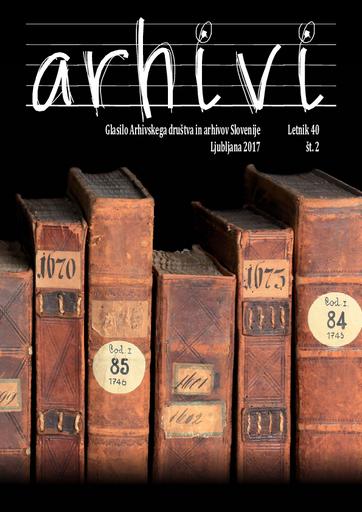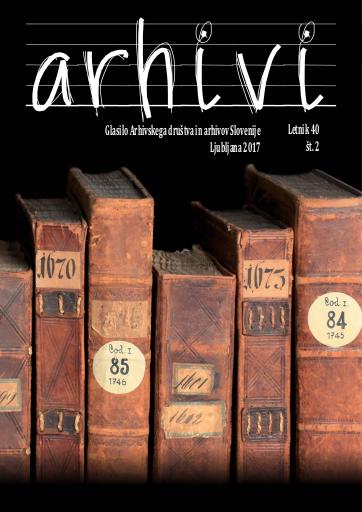/
Serijske publikacije
/
Arhivi
Minoriti štajersko-koroške province od prve polovice 16. stoletja do jožefinskih reform


To delo avtorja Igor Salmič je ponujeno pod Creative Commons Priznanje avtorstva-Nekomercialno-Deljenje pod enakimi pogoji 4.0 Mednarodna
Datoteke (1)

Opis
Prispevek govori o življenju in razvoju minoritov v štajersko-koroški provinci od srede 16. stoletja do konca 18. stoletja. Glavni vir za pisanje besedila je rokopis Brevis Descriptio Inclytae Provinciae Styriae et Carinthiae Ordinis Minorum S. Francisci Conventualium, ki ga je leta 1766 sestavil minorit Arsenius Platner. Po uvodu, kjer je govora o prihodu manjših bratov na slovensko ozemlje, je poseben poudarek na nekaterih osrednjih temah, ki se jih omenjeni rokopis dotakne: spor med konventuali in observanti, protestantizem, kvantitativna in kvalitativna rast province v 17. stoletju in prvi polovici 18. stoletja. Na kratko so predstavljene posledice jožefinskih reform, ki je za provinco polagoma pomenilo izgubo samostojnosti in združitev z avstrijsko provinco (med letoma 1832 in 1838). Na koncu pa je prikazan še prerez dvanajstih samostanov v provinci.
Metapodatki (12)
- identifikatorhttps://hdl.handle.net/11686/41535
- naslov
- Minoriti štajersko-koroške province od prve polovice 16. stoletja do jožefinskih reform
- Conventual Franciscans of Styrian-Carinthian Province from the 1st half of the 16th Century until Josephian Reforms
- avtor
- Igor Salmič
- soavtor
- Gregor Jenuš (gl. in odg. ur.)
- Dunja Mušič (teh. ur.)
- Petra Markuš (prev.)
- Tanja Martelanc (foto.)
- predmet
- ČLANKI IN RAZPRAVE
- minoriti
- konventuali
- observanti
- štajersko-koroška provinca
- Arsenius Platner
- protestantizem
- ARTICLES AND PAPERS
- Minorites
- conventuals
- observants
- Styrian Carinthian province
- Arsenius Platner
- Protestantism
- opis
- This contribution follows the evolution and happenings of Styrian-Carinthian province which was autonomous for almost 300 years, building on a little known but very precious source Brevis Descriptio inclytae Provinciae Styriae et Carinthiae Ordinis Fratrum Minorum Conventualium. Upon the presentation of developments, we were attentive to a broader geographical space which significantly influenced functioning and mentality of Conventual Franciscans of Styrian-Carinthian province with its characteristics. Some periods were marked by true flourishing as seen on the example of the 17th and the first half of the 18th centuries. This is evident from architecture since in that period baroque transformation of monastic and church spaces started in many places. The circumstances of the birth of the province itself are especially surprising. If the Brevis Descriptio is to be believed, the Styrian-Carinthian province gained autonomy at the time when numerous other communities and provinces decayed owing to the start of Protestant movement. The decline of the province at the end of the 18th century progressed in a similar manner to that of other monastic communities, the consequences of Josephian reforms being well known. Yet the picture is not complete. Some historians also pay attention to other causes that helped the situation deteriorate drastically. According to their view, those reasons need to be searched for within the order itself. We could cite the thoughts of Gennaro Bove who identified individual possession of funds as the weakness of Minorites. This was the practice that came to be increasingly obvious due to the broad interpretation in urban constitutions. Such behavior led many Minorite friars to a private way of life repeatedly and thus accelerated the spiritual dilution of the order. Only at the end of the 19th century, the Covnentual order once again formally introduced community life (vita communis perfecta) at the recommendations of Pope Leon XIII and the engagement of minister general Bonaventura Soldatić, thus gaining a new spiritual impetus. Some even speak of the new birth as the provinces that first adopted this reform were opening new outposts in Europe and around the world with the greatest zeal and spiritual power in the first half of the 20th century
- založnik
- Arhivsko društvo Slovenije
- datum
- 2017
- 01. 01. 2017
- tip
- besedilo
- jezik
- Slovenščina
- jeDelOd
- pravice
- licenca: ccByNcSa
